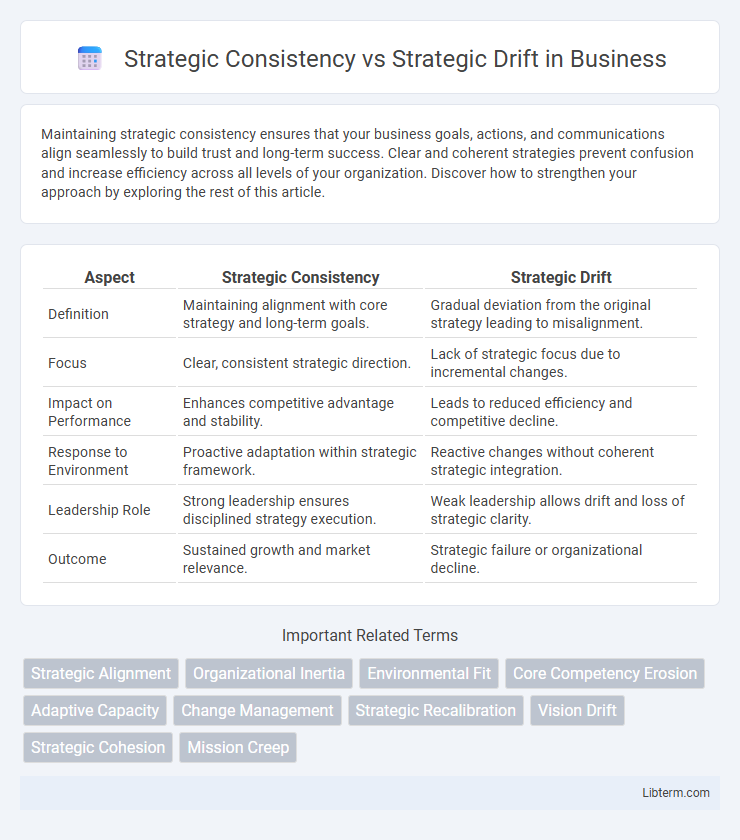Maintaining strategic consistency ensures that your business goals, actions, and communications align seamlessly to build trust and long-term success. Clear and coherent strategies prevent confusion and increase efficiency across all levels of your organization. Discover how to strengthen your approach by exploring the rest of this article.
Table of Comparison
| Aspect | Strategic Consistency | Strategic Drift |
|---|---|---|
| Definition | Maintaining alignment with core strategy and long-term goals. | Gradual deviation from the original strategy leading to misalignment. |
| Focus | Clear, consistent strategic direction. | Lack of strategic focus due to incremental changes. |
| Impact on Performance | Enhances competitive advantage and stability. | Leads to reduced efficiency and competitive decline. |
| Response to Environment | Proactive adaptation within strategic framework. | Reactive changes without coherent strategic integration. |
| Leadership Role | Strong leadership ensures disciplined strategy execution. | Weak leadership allows drift and loss of strategic clarity. |
| Outcome | Sustained growth and market relevance. | Strategic failure or organizational decline. |
Understanding Strategic Consistency
Strategic consistency ensures that an organization's actions, resources, and objectives align continuously with its long-term vision, enabling sustainable competitive advantage. Maintaining clear communication, strong leadership commitment, and regular performance evaluations reinforces this alignment across all levels. Organizations that prioritize strategic consistency adapt deliberately without compromising core goals, preventing the adverse effects of strategic drift.
Defining Strategic Drift
Strategic drift occurs when a company's strategy gradually becomes misaligned with the external environment due to subtle changes in markets, technologies, or customer preferences. This divergence creates a gap between the organization's strategic objectives and the realities of the competitive landscape, leading to decreased performance and competitive disadvantage. Maintaining strategic consistency requires continuous environmental scanning and adaptive decision-making to ensure alignment with evolving market dynamics.
Key Drivers of Strategic Consistency
Key drivers of strategic consistency include clear organizational vision, strong leadership commitment, and effective communication channels that ensure alignment across all levels of the company. Consistent resource allocation and robust performance measurement systems further reinforce adherence to strategic objectives. These elements collectively maintain strategic focus and prevent deviations that lead to strategic drift.
Causes of Strategic Drift
Strategic drift occurs when an organization's strategy gradually becomes misaligned with changes in the external environment due to complacency, poor environmental scanning, and resistance to change. Causes include failure to recognize emerging market trends, reliance on outdated assumptions, and ineffective communication within leadership teams. Such complacency results in declining competitiveness as the strategy no longer addresses evolving customer needs or technological advancements.
Impact of Consistency on Organizational Performance
Strategic consistency enhances organizational performance by ensuring alignment between goals, resources, and actions, resulting in focused efforts and efficient resource utilization. Companies maintaining strategic consistency experience higher market competitiveness, improved financial outcomes, and stronger brand reputation. In contrast, strategic drift causes misalignment that can lead to operational inefficiencies, reduced employee morale, and decreased profitability.
Risks Associated with Strategic Drift
Strategic drift poses significant risks including misalignment between organizational goals and market dynamics, leading to decreased competitive advantage and reduced profitability. Failure to adapt to external changes such as technological advancements or customer preferences can result in lost market share and organizational stagnation. Companies experiencing strategic drift often face internal confusion, resource misallocation, and diminished employee morale, all of which threaten long-term sustainability.
Detecting Early Signs of Strategic Drift
Detecting early signs of strategic drift involves continuous monitoring of market trends, competitor actions, and internal performance metrics to ensure alignment with defined strategic goals. Organizations should implement regular strategic reviews and engage frontline employees to identify discrepancies between current practices and long-term objectives. Utilizing data analytics and feedback loops enhances the ability to recognize subtle shifts before they evolve into significant strategic misalignment.
Balancing Stability and Flexibility in Strategy
Balancing stability and flexibility in strategy requires maintaining strategic consistency to ensure long-term goals and core values remain intact while allowing adaptive responses to environmental changes to prevent strategic drift. Organizations must establish robust frameworks that integrate regular environmental scanning with iterative strategy reviews to detect early signs of misalignment. Effective balancing preserves competitive advantage by aligning resources and capabilities with evolving market conditions without compromising strategic coherence.
Real-world Case Studies: Successes and Failures
Strategic consistency enables companies like Apple to maintain long-term competitive advantages by aligning resources and goals with market demands, while strategic drift caused Nokia to lose its dominance due to failure in adapting to smartphone trends. Real-world cases demonstrate that firms adhering to coherent strategies, such as Amazon's continuous innovation, achieve sustained growth, whereas those experiencing strategic drift, like Kodak, suffer market share erosion and decline. These examples highlight the importance of ongoing strategic alignment and responsive adaptation to industry dynamics for organizational success.
Best Practices for Maintaining Strategic Alignment
Maintaining strategic alignment requires regular environmental scanning and performance reviews to promptly identify deviations that cause strategic drift. Implementing clear communication channels ensures that organizational goals are consistently understood and reinforced across all levels, promoting strategic consistency. Utilizing adaptive planning processes and aligning resource allocation with core objectives further strengthens the organization's ability to sustain strategic focus and respond effectively to market changes.
Strategic Consistency Infographic

 libterm.com
libterm.com